2023 SUBARU BRZ ECU
[x] Cancel search: ECUPage 58 of 432
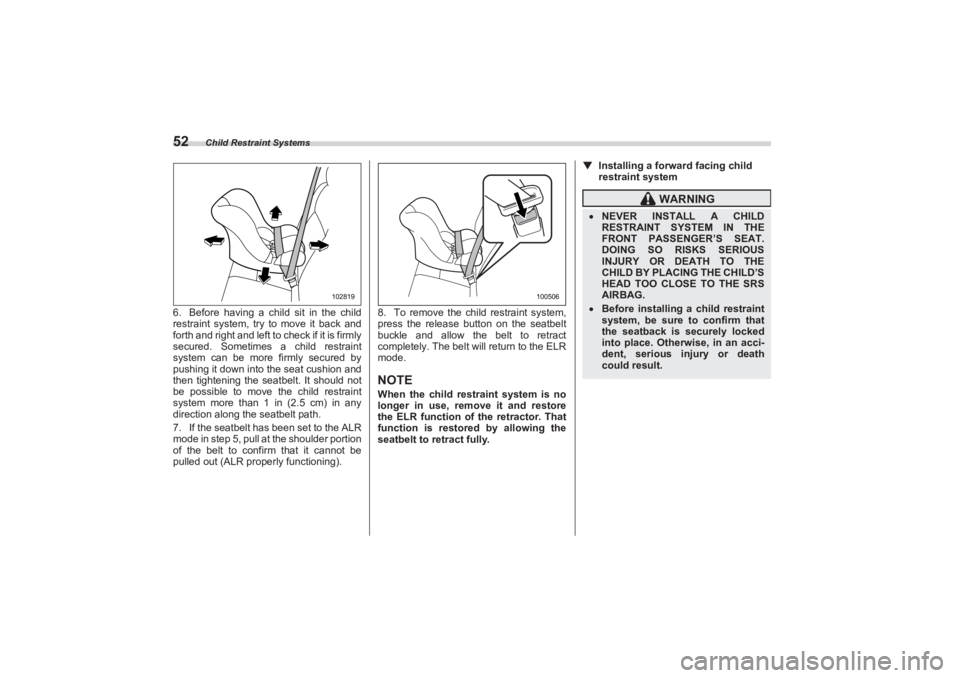
Child Restraint Systems
526. Before having a child sit in the child
restraint system, try to move it back and
forth and right and left to check if it is firmly
secured. Sometimes a child restraint
system can be more firmly secured by
pushing it down into the seat cushion and
then tightening the seatbelt. It should not
be possible to move the child restraint
system more than 1 in (2.5 cm) in any
direction along the seatbelt path.
7. If the seatbelt has been set to the ALR
mode in step 5, pull at the shoulder portion
of the belt to confir m that it cannot be
pulled out (ALR properly functioning). 8. To remove the child restraint system,
press the release button on the seatbelt
buckle and allow the belt to retract
completely. The belt will return to the ELR
mode.
NOTEWhen the child restraint system is no
longer in use, remove it and restore
the ELR function of the retractor. That
function is restored by allowing the
seatbelt to retract fully.
▼ Installing a forward facing child
restraint system
102819
100506
WARNING
NEVER INSTALL A CHILD
RESTRAINT SYSTEM IN THE
FRONT PASSENGER’S SEAT.
DOING SO RISKS SERIOUS
INJURY OR DEATH TO THE
CHILD BY PLACING THE CHILD’S
HEAD TOO CLOSE TO THE SRS
AIRBAG. Before installing a child restraint
system, be sure to confirm that
the seatback is securely locked
into place. Otherwise, in an acci-
dent, serious injury or death
could result.
BRZ_U.book 52 ページ 2022年3月29日 火曜日 午後3時59分
Page 59 of 432
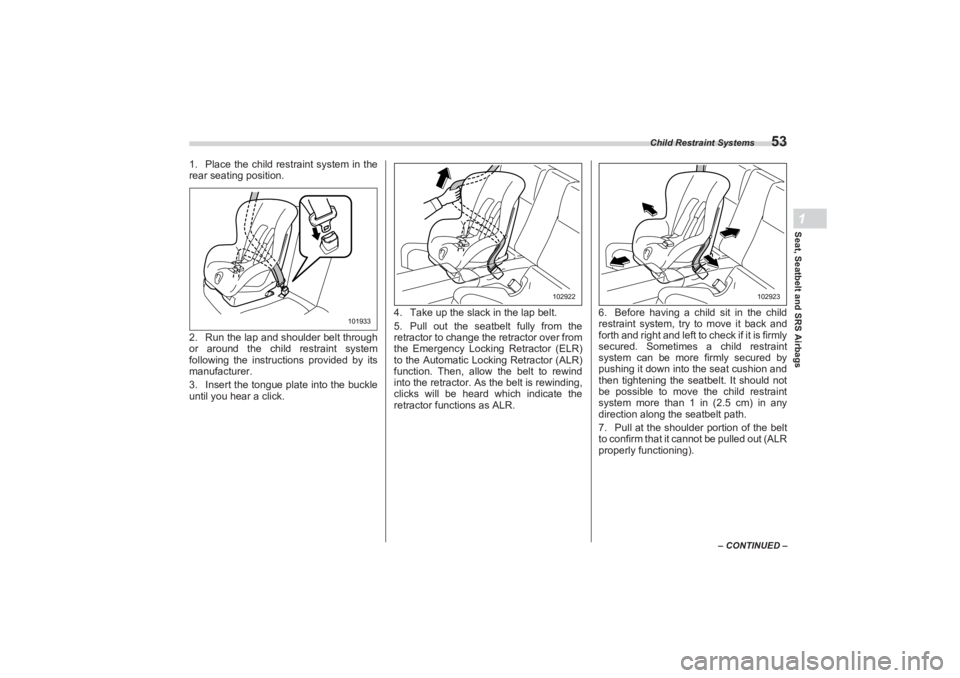
Child Restraint Systems
53
Seat, Seatbelt and SRS Airbags1
– CONTINUED –
1. Place the child restraint system in the
rear seating position.
2. Run the lap and shoulder belt through
or around the child restraint system
following the instructions provided by its
manufacturer.
3. Insert the tongue plate into the buckle
until you hear a click. 4. Take up the slack in the lap belt.
5. Pull out the seatbelt fully from the
retractor to change the retractor over from
the Emergency Locking Retractor (ELR)
to the Automatic Locking Retractor (ALR)
function. Then, allow the belt to rewind
into the retractor. As the belt is rewinding,
clicks will be heard which indicate the
retractor functions as ALR. 6. Before having a child sit in the child
restraint system, try to move it back and
forth and right and left to check if it is firmly
secured. Sometimes a child restraint
system can be more firmly secured by
pushing it down into the seat cushion and
then tightening the seatbelt. It should not
be possible to move the child restraint
system more than 1 in (2.5 cm) in any
direction along the seatbelt path.
7. Pull at the shoulder portion of the belt
to confirm that it cannot be pulled out (ALR
properly functioning).
101933
102922
102923
BRZ_U.book 53 ページ 2022年3月29日 火曜日 午後3時59分
Page 61 of 432
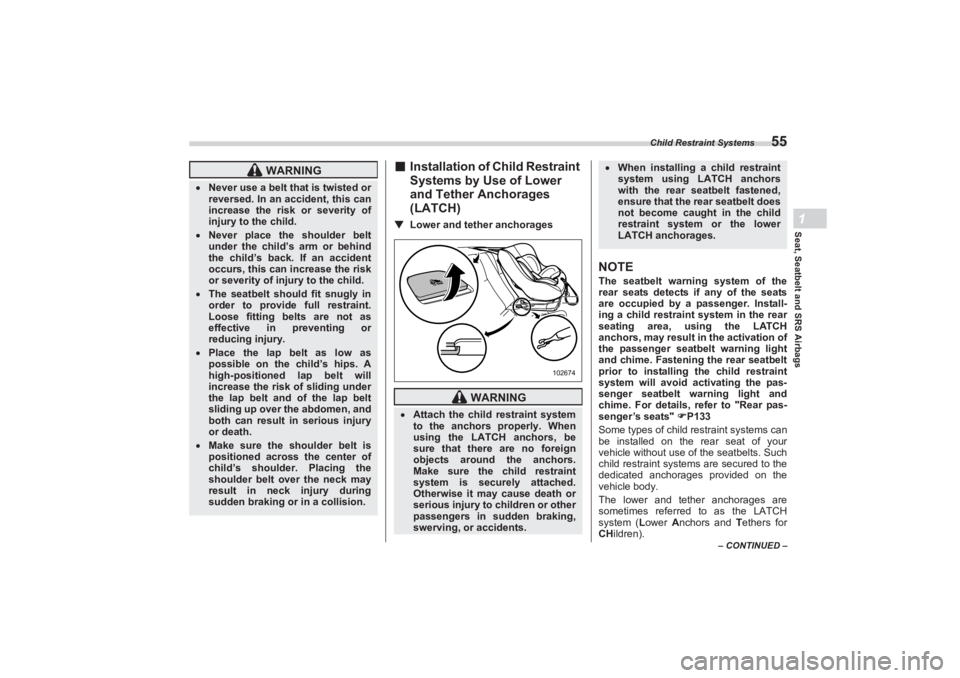
Child Restraint Systems
55
Seat, Seatbelt and SRS Airbags1
– CONTINUED –
■Installation of Child Restraint
Systems by Use of Lower
and Tether Anchorages
(LATCH)▼ Lower and tether anchorages
NOTEThe seatbelt warning system of the
rear seats detects if any of the seats
are occupied by a passenger. Install-
ing a child restraint system in the rear
seating area, using the LATCH
anchors, may result in the activation of
the passenger seatbelt warning light
and chime. Fastening the rear seatbelt
prior to installing the child restraint
system will avoid activating the pas-
senger seatbelt warning light and
chime. For details, refer to "Rear pas-
senger’s seats" P133
Some types of child restraint systems can
be installed on the rear seat of your
vehicle without use of the seatbelts. Such
child restraint systems are secured to the
dedicated anchorages provided on the
vehicle body.
The lower and tether anchorages are
sometimes referred to as the LATCH
system ( Lower Anchors and T ethers for
CHildren).
WARNING
Never use a belt that is twisted or
reversed. In an accident, this can
increase the risk or severity of
injury to the child. Never place the shoulder belt
under the child’s arm or behind
the child’s back. If an accident
occurs, this can increase the risk
or severity of injury to the child. The seatbelt should fit snugly in
order to provide full restraint.
Loose fitting belts are not as
effective in preventing or
reducing injury. Place the lap belt as low as
possible on the child’s hips. A
high-positioned lap belt will
increase the risk of sliding under
the lap belt and of the lap belt
sliding up over the abdomen, and
both can result in serious injury
or death. Make sure the shoulder belt is
positioned across the center of
child’s shoulder. Placing the
shoulder belt over the neck may
result in neck injury during
sudden braking or in a collision.
WARNING
Attach the child restraint system
to the anchors properly. When
using the LATCH anchors, be
sure that there are no foreign
objects around the anchors.
Make sure the child restraint
system is securely attached.
Otherwise it may cause death or
serious injury to children or other
passengers in sudden braking,
swerving, or accidents.
102674
When installing a child restraint
system using LATCH anchors
with the rear seatbelt fastened,
ensure that the rear seatbelt does
not become caught in the child
restraint system or the lower
LATCH anchorages.
BRZ_U.book 55 ページ 2022年3月29日 火曜日 午後3時59分
Page 63 of 432

Child Restraint Systems
57
Seat, Seatbelt and SRS Airbags1
– CONTINUED –
in the above illustration. For details, refer
to "Top Tether Anchorages" P59.
▽ To install a child restraint
system using lower and tether
anchorages
1. Move the seatback back and forth to
confirm that it is securely locked into
place.
Check that the red colored
unlocking marker on the lock release
button is not visible. For details, refer
to "Folding Down the Rear Seatback"
P37. 2. You will find “ ” marks at the bottoms
of the rear seatback. These marks indi-
cate the positions of the lower anchorages
(bars).
Each lower anchorage is located behind
the cover of seatback bottom. Peel off the anchorage cover completely
from the selected side of the rear
seatback to expose the anchorages (bars)
to be used for installation of the child
restraint system.
If it is hard to install the child restraint
system because the anchorage cover
returns to the original position, press the
anchorage cover to the seat cushion until
it is flat.
WARNING
Before installing a child restraint
system, be sure to confirm that the
seatback is securely locked into
place. Otherwise, in an accident,
serious injury or death could result.
CAUTION
When you install a child restraint
system, follow the manufacturer’s
instructions supplied with it. After
installing the child restraint system,
check to ensure that it is held
securely in position. If it is not held
tight and secure, the danger of your
child suffering personal injury in
the event of an accident may be
increased.
102678
102760
BRZ_U.book 57 ページ 2022年3月29日 火曜日 午後3時59分
Page 64 of 432
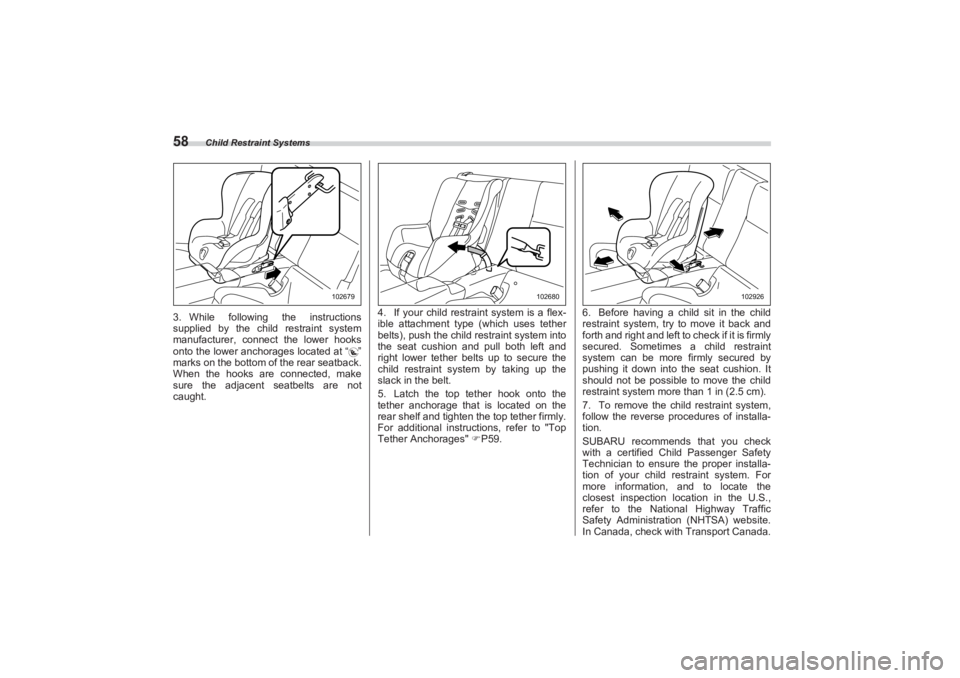
Child Restraint Systems
583. While following the instructions
supplied by the child restraint system
manufacturer, connect the lower hooks
onto the lower anchorages located at “ ”
marks on the bottom of the rear seatback.
When the hooks are connected, make
sure the adjacent seatbelts are not
caught. 4. If your child restraint system is a flex-
ible attachment type (which uses tether
belts), push the child restraint system into
the seat cushion and pull both left and
right lower tether belts up to secure the
child restraint system by taking up the
slack in the belt.
5. Latch the top tether hook onto the
tether anchorage that is located on the
rear shelf and tighten the top tether firmly.
For additional instructions, refer to "Top
Tether Anchorages" P59. 6. Before having a child sit in the child
restraint system, try to move it back and
forth and right and left to check if it is firmly
secured. Sometimes a child restraint
system can be more firmly secured by
pushing it down into the seat cushion. It
should not be possible to move the child
restraint system more than 1 in (2.5 cm).
7. To remove the child restraint system,
follow the reverse procedures of installa-
tion.
SUBARU recommends that you check
with a certified Child Passenger Safety
Technician to ensure the proper installa-
tion of your child restraint system. For
more information, and to locate the
closest inspection location in the U.S.,
refer to the National Highway Traffic
Safety Administration (NHTSA) website.
In Canada, check with Transport Canada.
102679
102680
102926
BRZ_U.book 58 ページ 2022年3月29日 火曜日 午後3時59分
Page 66 of 432
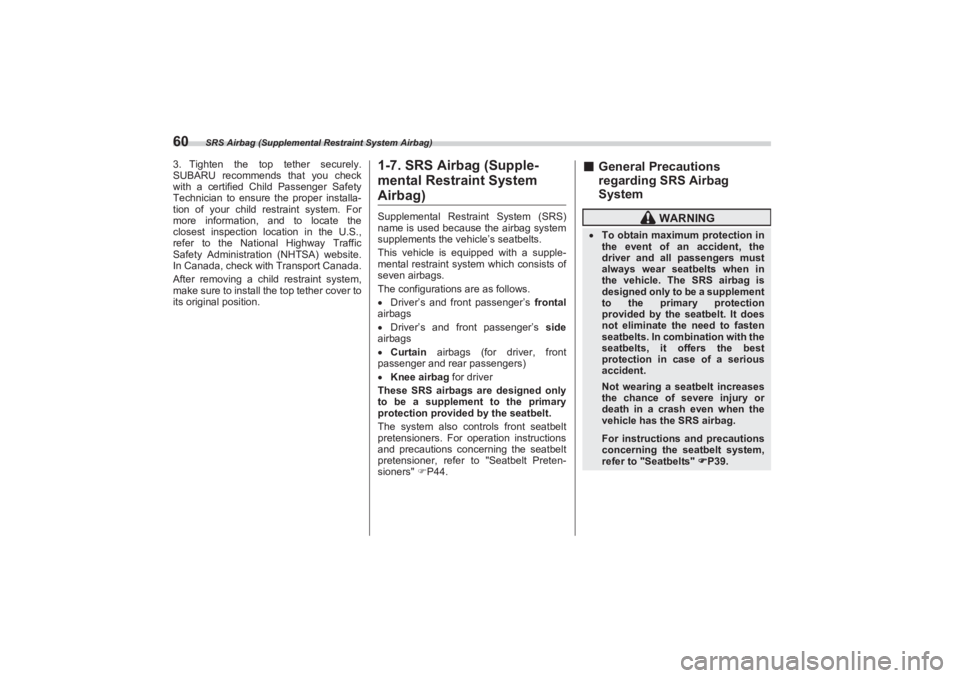
SRS Airbag (Supplemental Restraint System Airbag)
603. Tighten the top tether securely.
SUBARU recommends that you check
with a certified Child Passenger Safety
Technician to ensure the proper installa-
tion of your child restraint system. For
more information, and to locate the
closest inspection location in the U.S.,
refer to the National Highway Traffic
Safety Administrati on (NHTSA) website.
In Canada, check with Transport Canada.
After removing a ch ild restraint system,
make sure to install the top tether cover to
its original position.
1-7. SRS Airbag (Supple -
mental Restraint System Airbag)Supplemental Restraint System (SRS)
name is used because the airbag system
supplements the vehi cle’s seatbelts.
This vehicle is equipped with a supple-
mental restraint system which consists of
seven airbags.
The configurations are as follows.
Driver’s and front passenger’s frontal
airbags
Driver’s and front passenger’s side
airbags
Curtain airbags (for driver, front
passenger and rear passengers)
Knee airbag for driver
These SRS airbags are designed only
to be a supplement to the primary
protection provided by the seatbelt.
The system also cont rols front seatbelt
pretensioners. For operation instructions
and precautions conc erning the seatbelt
pretensioner, refer to "Seatbelt Preten-
sioners" P44.
■ General Precautions
regarding SRS Airbag
System
WARNING
To obtain maximum protection in
the event of an accident, the
driver and all passengers must
always wear seatbelts when in
the vehicle. The SRS airbag is
designed only to be a supplement
to the primary protection
provided by the seatbelt. It does
not eliminate the need to fasten
seatbelts. In combination with the
seatbelts, it offers the best
protection in case of a serious
accident.
Not wearing a seatbelt increases
the chance of severe injury or
death in a crash even when the
vehicle has the SRS airbag.For instructions and precautions
concerning the seatbelt system,
refer to "Seatbelts" P39.
BRZ_U.book 60 ページ 2022年3月29日 火曜日 午後3時59分
Page 71 of 432
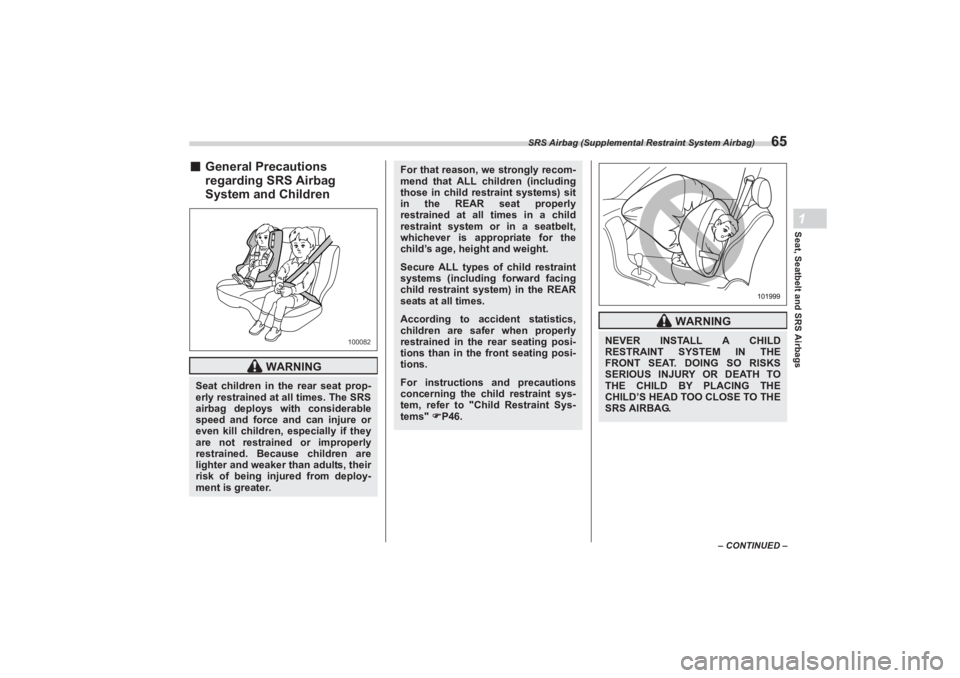
SRS Airbag (Supplemental Restraint System Airbag)
65
Seat, Seatbelt and SRS Airbags1
– CONTINUED –
■General Precautions
regarding SRS Airbag
System and Children
WARNING
Seat children in the rear seat prop-
erly restrained at all times. The SRS
airbag deploys with considerable
speed and force and can injure or
even kill children, especially if they
are not restrained or improperly
restrained. Because children are
lighter and weaker than adults, their
risk of being injured from deploy-
ment is greater.
100082
For that reason, we strongly recom-
mend that ALL children (including
those in child rest raint systems) sit
in the REAR seat properly
restrained at all times in a child
restraint system or in a seatbelt,
whichever is appropriate for the
child’s age, height and weight.Secure ALL types of child restraint
systems (including forward facing
child restraint system) in the REAR
seats at all times.According to accident statistics,
children are safer when properly
restrained in the rear seating posi-
tions than in the front seating posi-
tions.For instructions and precautions
concerning the child restraint sys-
tem, refer to "Ch ild Restraint Sys-
tems" P46.
WARNING
NEVER INSTALL A CHILD
RESTRAINT SYSTEM IN THE
FRONT SEAT. DOING SO RISKS
SERIOUS INJURY OR DEATH TO
THE CHILD BY PLACING THE
CHILD’S HEAD TOO CLOSE TO THE
SRS AIRBAG.
101999
BRZ_U.book 65 ページ 2022年3月29日 火曜日 午後3時59分
Page 77 of 432

SRS Airbag (Supplemental Restraint System Airbag)
71
Seat, Seatbelt and SRS Airbags1
– CONTINUED –
▼Front passenger’s SRS frontal
airbagThe front passenger’s SRS frontal airbag
uses a dual stage inflator. The inflator
operates in different ways depending on
the severity of impact.1) Occupant detection sensorsThe occupant detection sensors are
installed between the seat and seat rails,
and monitor the physique and posture of
the front passenger. Using this informa-
tion, the occupant detection system deter-
mines whether the front passenger’s SRS
frontal airbag should be deployed or not.
The occupant detect ion system may not
inflate the front passenger’s SRS frontal
airbag even when the driver’s SRS frontal
airbag deploys. This is normal. In this
case, although the front passenger’s SRS frontal airbag does not operate, the front
passenger’s seatbelt pretensioner oper-
ates with the driver’s seatbelt
pretensioner. For details about the
seatbelt pretensioner, refer to "Seatbelt
Pretensioners" P44.
102171
1
CAUTION
Observe the following precautions.
Failure to do so may prevent the
SUBARU advanced frontal airbag
system from functioning correctly
or cause the system to fail. Do not apply any strong impact to
the front passenger’s seat such
as by kicking. Do not let rear passengers rest
their feet between the front
seatback and seat cushion. Do not remove or disassemble
the front passenger’s seat. Do not install any accessory
(such as an audio amplifier) other
than a genuine SUBARU acces-
sory under the front passenger’s
seat. Do not place anything (shoes,
umbrella, etc.) under the front
passenger’s seat.
Do not place any objects (books,
etc.) around the front
passenger’s seat. Do not use the front passenger’s
seat with the head restraint
removed. Do not leave any articles on the
front passenger’s seat or the
seatbelt tongue and buckle
engaged when you leave your
vehicle. Do not put sharp object(s) on the
seat or pierce the seat uphol-
stery. Do not place a magnet near the
seatbelt buckle and the seatbelt
retractor. Do not use front seats with their
backward-forward position and
seatback not being locked into
place securely. If any of them are
not locked securely, adjust them
again. For adjusting procedure,
refer to "Manual Seat" P33
(models equipped with manual
seats only).
BRZ_U.book 71 ページ 2022年3月29日 火曜日 午後3時59分